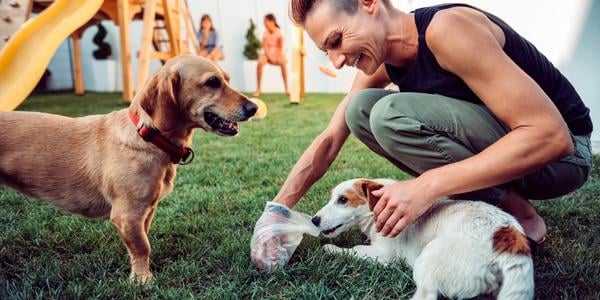 After years of working with animals, not much can gross me out. But the one thing that still does and always will is poop-eating! And there's nothing worse than cleaning up dog poo-vomit.
After years of working with animals, not much can gross me out. But the one thing that still does and always will is poop-eating! And there's nothing worse than cleaning up dog poo-vomit.
My younger dog has a penchant for snacking on only my older dog's poop. Luckily, he won't eat his own or other dogs' poop we see on walks.\And when it comes to wildlife poo, he would rather roll in rabbit poop than eat it.
When a dog eats feces, it's called coprophagia. They may eat their own poop or another animal's poop, such as the cat's "kitty rocha" from the litter box or rabbit droppings in the yard.
Poop eating is most often seen in puppies, but can become a lifelong issue if not addressed. And it is something you'll want to stop, as eating poop can indicate health issues and has health risks considering that our dogs put their mouths on lots of things in our homes (including licking us).
In my quest to solve this poop-eating problem for my own dog, I've learned quite a lot from talking with my veterinarian about why dogs do this and what actually works to stop it.
For audio/visual learners, there is a video at the end of this article that provides an article summary to address why your dog eats poop. Don't worry, there are no visuals of the actual act.
Table of Contents
Reasons Dogs Eat Poop
Nutritional Deficiencies
A dog may eat poop because they are missing important nutrients in their own diet or they are not properly absorbing certain nutrients in their food during digestion (called malabsorption).
One study found that dogs whose diets were deficient in thiamine (vitamin B1) developed coprophagia. If your veterinarian suspects deficiencies, they will run specific tests not included in a usual wellness blood panel.
Nutritional deficiencies are not common for dogs fed commercial diets, and are instead more common in dogs fed raw or homemade diets.
Underlying Medical Issues
If a dog suddenly begins to eat feces, it may be a sign of health conditions that cause increased appetite, such as diabetes, Cushing's disease, hypothyroidism, exocrine pancreatic insufficiency, or any gastrointestinal disease that causes malabsorption.
Diseases that can lead to pica (eating inappropriate things), such as liver disease and anemia, can result in coprophagia. Canine cognitive dysfunction ("doggie dementia") can also contribute to this behavior.
Intestinal Parasites
Intestinal parasites like roundworms, hookworms, or whipworms, "steal" nutrients from your dog's diet, which can cause inflammation and malabsorption. That can then can lead to coprophagia.
Anxiety
Stool eating may be a symptom of underlying anxiety or stress in a dog. This may be separation anxiety or isolation distress, or a dog who is seeking to avoid punishment during potty training (hiding the evidence!).
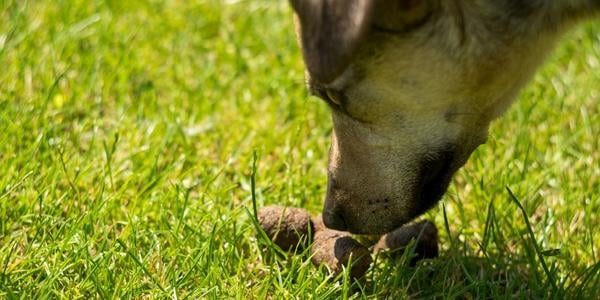
Hunger
Eating stool may be a sign that a dog is simply hungry and seeking more calories. Dogs who are taking steroidal treatments, such as prednisone, often have a larger appetite and may begin to eat poop.
Cleaning the "Den"
When raising a litter of puppies, for the first few weeks after birth, a mother dog will lick the puppies' rears to stimulate bowel movements and then eat the puppies' feces. This is completely normal and expected behavior and is believed to happen due to their desire to keep the den area clean and protect against predators (who may smell the poop and therefore find the den location).
It Just Tastes Good!
While we may automatically wrinkle our noses at the idea that our dogs just find poop tasty, it just may be that they like the taste. Feces is simply digested food. And if your dog is eating other dog or cat feces, to them, it's just another protein source!
If they prefer horse or rabbit poop, perhaps they like the taste of digested plants.
Inappropriate Association with Food
This is related to the prior point about dogs liking the taste of feces. In some cases, a dog may associate poop with food because their eating area was located too close to their potty area during critical development phases.
This can happen with dogs who spent a lot of time in confinement without a separate potty area, such as in puppy mills or an overcrowded shelter.
Attention Seeking or Boredom
Dogs learn quickly that eating poop is a surefire way of getting your attention, as when we see it happen, we tend to immediately respond by shouting and running after them. They may start repeating this behavior to get your attention and can even see it as a fun game to play when you're around.
If a dog is bored, they may seek out things to indulge in, including finding and eating feces in the yard or taking on the challenge of accessing the cat's litter box for a snack.
Can a Dog Get Sick from Eating Poop?
While consuming poop isn’t a major medical issue, what that poo contains can be. When eating poop, your dog has an increased risk for certain diseases, such as E.coli, Salmonella, giardia, or parvovirus.
Consumption can increase their risks of intestinal parasite infection as well. There are even documented cases, albeit not common, of pets absorbing certain undigested medications from consuming poop.
If your dog consumes their own or another household pet's poop but all are parasite-free, make sure they are on year-round preventatives and have regular fecal exams to ensure their continued health.
Staying up-to-date on preventatives is also extremely important if your dog eats other dogs' feces at dog parks or on walks.
You'll also want to consider that your dog puts their mouth on quite a lot of things in your home — not to mention that they probably lick your face or hands. If they eat poop, you're then also at risk of illness and disease transmission such as Salmonella and giardia.
How to Stop Your Dog from Eating Poop
Talk to Your Veterinarian
The first thing we always want to do is rule out health reasons for behavior issues. Speak with your veterinarian about your dog's poop-eating behavior. Ask them if they have recommendations on food or supplements to add to their diet.
They may refer you to a veterinary nutritionist for further testing and treatment.
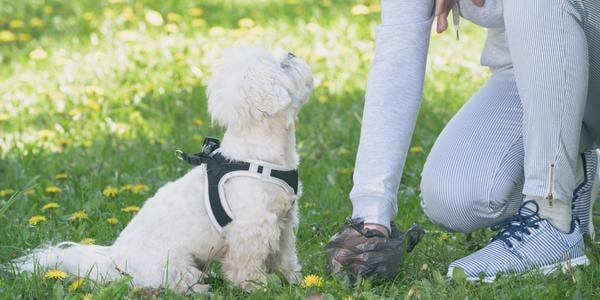 The Solution: Prevent Poop Eating With Management
The Solution: Prevent Poop Eating With Management
The most effective thing you can do, no matter the reason your dog is eating poop, is to remove access to it. If they can't get to it, they can't eat it! How you do this depends on whose poop they are eating.
Pick up Poop Right Away.
For my dog, he prefers my older female dog's poop, but not his own. This means that I must be very quick to immediately bag up her poop when she goes. But I have more leeway when it comes to scooping his poop in the yard.
Whenever we go out for a potty break in the yard, I make sure to have a bag ready in my pocket and keep a close eye on her to make sure I don't miss any droppings. Be prepared with your poop scooper or poo bags whenever you take your dogs outside.
Keep Your Dog Out of the Litterbox.
Block your dog's access to the cat's litterbox. Use gates or strategic locations for the litter box, and make sure to clean it regularly. For more ideas, check out "6 Tips to Keep Your Dog Out of the Litterbox."
Prevent Scavenging.
Dogs are scavengers by nature, and "training" this out of them is a big ask. In some cases, managing their environment and using anti-scavenging tools solves the problem. But for extreme cases, while you work on teaching your dog to leave poop alone, invest in these tools to prevent them from practicing this unwanted behavior.
Anti-scavenging muzzles. I recommend muzzle training for all dogs, but it's particularly useful for dogs who like to grab and eat feces. Choose a basket muzzle that is designed with a front guard, like this Baskerville Anti-Scavenge muzzle.
The JAFCO muzzle is also a good option, or if you have a basket muzzle custom-made, make sure to choose a tightly woven front design. While a basket muzzle will still allow a dog to shove their snout into a pile of poo, ideally it will block actual ingestion.
Just be ready with sani wipes and clean your muzzle after each use. For more tips on finding the right muzzle for your dog, check out my tips in "Choosing and Fitting a Basket Muzzle."
Field Guards. An alternative to a basket muzzle, a product like the Outfox Field Guard prevents your dog from ingesting feces they find. However, just like a muzzle, your dog may still decide to smear poo all over it.
But this product is especially useful if you live in an area where foxtails are prevalent.
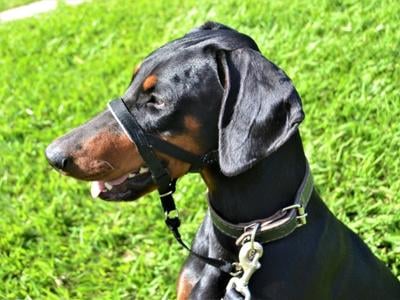 Use a head collar on walks. If your dog likes to treat your walk like a poop buffet, grazing on found poop along the way, walking them on a head collar, such as a Halti, can give you better control over where their nose goes.
Use a head collar on walks. If your dog likes to treat your walk like a poop buffet, grazing on found poop along the way, walking them on a head collar, such as a Halti, can give you better control over where their nose goes.
Using this walking gear, you can keep their nose up from the ground and prevent scavenging.
This is usually my last recommendation, as sniffing is an essential activity for your dog to engage in every day.
However, using a head collar for leash walking in areas where there is a lot of wildlife poop and then allowing them the freedom to sniff in "free-of-poop" areas is a good compromise.
I only recommend using a head collar, if you can commit to spending lots of time conditioning your dog to wear it comfortably first. I do not recommend head collars for small dogs or dogs who pull or lunge on the leash, as the sudden torque on the neck can cause injury.
Feed Your Dog High-Quality Food
Consult with your veterinarian to be sure that your dog's food is a high-quality and well-balanced diet appropriate for your dog’s age and activity level. To function properly, dogs need a balanced diet containing proteins, fats, carbohydrates, vitamins, and minerals that match their life stage.
You want to feed a diet that is meat-based (listed in the first two to three ingredients), but that also has a balance of carbohydrates (vegetables, quality grains, and fruits).
Feed Your Dog More Often
Feeding your dog smaller meals more frequently throughout the day may help reduce hunger and scavenging behavior, which could be contributing to their coprophagia. Be aware that if you're still working on your dog's potty training, changing their meal frequency may affect how many times and the time they need to go #2 every day.
Increase Mental Enrichment
To reduce boredom and decrease stress, give your dog more brain games and mental enrichment. Licking, chewing, and sniffing are especially helpful for decompression and reducing anxiety.
The easiest way to enrich your dog's life is to make every meal a brain or foraging activity. You can do this with a snuffle mat or puzzle feeder. There are tons of ways to increase enrichment, many of which don't involve more food. Check out Dog Enrichment: Toys, Games, and DIY Ideas for more ways to satisfy your dog's natural instincts.
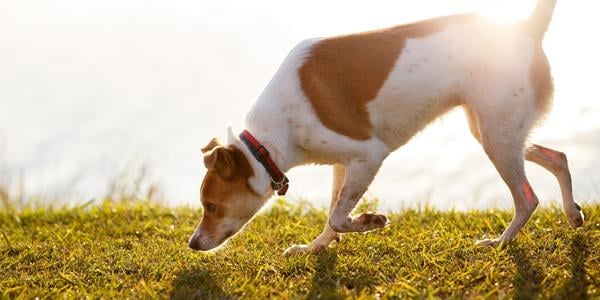
Teach Your Dog to Leave Poop Alone
You can train your dog to leave things alone when asked; you just need to introduce and practice the Leave It cue. One thing to think about here is that typically we have to be present to say "leave it" for our dogs to actually be successful with this. Combine leave it practice with management and prevention techniques for true success.
You can take the regular leave it cue to the next level by teaching an automatic leave it. This skill is difficult and takes quite a bit of practice! It can be done, but be aware that you are competing with a dog's natural instinct to scavenge.
To introduce an automatic leave it, you'll want to make the presence of poo the cue for your dog, not your verbal "leave it."
Introducing the Automatic Leave It
- Have a pocket full of high-value treats and your dog on a leash.
- Approach a pile of poo, but don't allow your dog close enough to eat it.
- When they notice it, simply wait.
- When they turn their head away from or step away from the poop, say "yes!" (or click if you're using a clicker) and reward heavily at a distance away from the poo pile.
- Repeat, repeat, repeat.
This process takes time and lots of repetitions. It's best to work with a certified trainer on this skill, as this is what we consider a "college level" skill, and training needs to be tailored to each individual dog for the best success.
In some cases, we may install a cue transfer, where we teach the dog to recall when they find poop or do an automatic check-in. It depends on the dog's foundational skills and the context that usually ends with poop eating.
Poop Eating Deterrent Products
There are a few different products available that claim to stop poop eating in dogs. Unfortunately, over-the-counter poop-eating deterrent products simply don't deliver on their promises. According to this 2018 study, there were "no successful results in treating coprophagy with any of the commercial products."
If it's difficult to manage your dog's environment to prevent stool eating, you may be considering trying out a deterrent. First: speak with your veterinarian about what they may recommend and what, if any, ingredients may interact with any medications your dog is taking.
I recommend first trying natural diet additives to balance your dog's gastrointestinal system prior to exploring commercial products.
Natural Poop Eating Deterrents
- Pre and Probiotics: Providing your dog with a pre and probiotic enhances their digestion, nutrient absorption, and boosts their immune system. Use a multi-strain product with a high CFU per dose. See our veterinarian's top picks for probiotics here.
- Digestive enzymes: Consult with your veterinarian to determine if your dog needs digestive enzymes, which are typically only available by prescription. They can help improve the digestion and absorption of nutrients resulting in less palatable poop.
- Vitamin B Supplements: If your pet is diagnosed with a malabsorption issue or Vitamin B deficiency, your veterinarian may recommend B-complex injections.
- Canned pumpkin: Add a couple of teaspoons to tablespoons of canned pumpkin (depending on your dog’s size) to their food. This increases fiber content and may make feces less appealing to eat. Note: Only use pure pumpkin — avoid pumpkin pie filling.
- Green Veggies: Add vegetables high in fiber to your dog's diet, such as spinach, kale, green beans, or broccoli.
- Small Amount of Well-Cooked Grain: Such as cooked oats, rice, or quinoa.
- Pineapple: There are no scientific studies to support this, but an old legend suggests that feeding your dog small pieces of fresh pineapple (never canned) will make the taste of their poop unappealing.
- Meat tenderizer: Both myself and Preventive Vet's team veterinarian are wary to recommend adding meat tenderizer to a dog's diet to prevent coprophagia. Why? Well, many meat tenderizers have other ingredients that can be toxic to dogs, such as high sodium, onion, and garlic.
Bromelain, the actual "tenderizer" in these products, is present in fresh pineapple, so you're better off trying that before adding meat tenderizer to your dog's food. But just like with pineapple, there are no studies that show this is effective.
There are quite a few recommendations that will pop up on Google when you search for home remedies for stopping poop eating. Be very careful what you try with your dog, and it's always a good idea to ask your veterinarian first.
As mentioned above with meat tenderizers, there may be additional ingredients that can be toxic to dogs.
For example, one suggestion I found is to sprinkle crushed breath mints on a dog's food, but many sugar-free breath mints contain the sugar substitute xylitol — which is extremely dangerous to dogs.
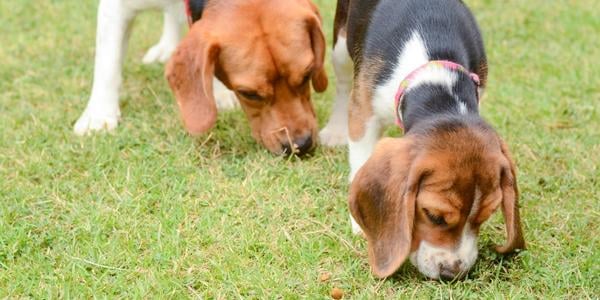
Does For-Bid™ Work for Dogs?
I had a very brief experience trying For-bid™ to see if it would work for my dog. I actually stopped using the product after just two days because my veterinarian informed me that it has high sodium content that she didn't recommend for my senior dog to take — the second ingredient is MSG (monosodium glutamate). MSG can be toxic for dogs in high amounts or with long-term consumption.
However, if only used for a short period of time, the benefits may outweigh any risks. MSG only has one-third of the sodium content of regular table salt. If a dog is drinking adequate amounts of water, they will likely be fine to use For-Bid™ for the recommended five days.
Some dogs do get vomiting and diarrhea. Speak to your veterinarian first before use, especially if your dog has heart or kidney issues.
Article Video Summary
Does your dog eat poop? We'd love to hear about what you've tried to stop it — take this short 2-minute survey to share your experience!




